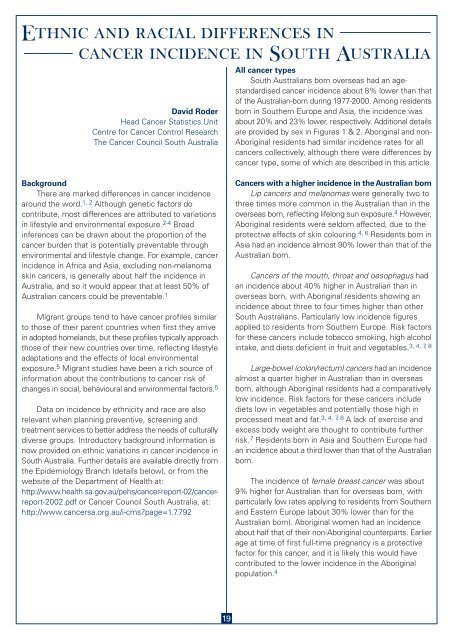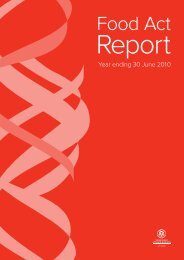Public Health Bulletin Edition 1, 2004 - SA Health - SA.Gov.au
Public Health Bulletin Edition 1, 2004 - SA Health - SA.Gov.au
Public Health Bulletin Edition 1, 2004 - SA Health - SA.Gov.au
Create successful ePaper yourself
Turn your PDF publications into a flip-book with our unique Google optimized e-Paper software.
Ethnic and racial differences in<br />
cancer incidence in South Australia<br />
David Roder<br />
Head Cancer Statistics Unit<br />
Centre for Cancer Control Research<br />
The Cancer Council South Australia<br />
All cancer types<br />
South Australians born overseas had an agestandardised<br />
cancer incidence about 8% lower than that<br />
of the Australian-born during 1977-2000. Among residents<br />
born in Southern Europe and Asia, the incidence was<br />
about 20% and 23% lower, respectively. Additional details<br />
are provided by sex in Figures 1 & 2. Aboriginal and non-<br />
Aboriginal residents had similar incidence rates for all<br />
cancers collectively, although there were differences by<br />
cancer type, some of which are described in this article.<br />
Background<br />
There are marked differences in cancer incidence<br />
around the word. 1, 2 Although genetic factors do<br />
contribute, most differences are attributed to variations<br />
in lifestyle and environmental exposure. 2-4 Broad<br />
inferences can be drawn about the proportion of the<br />
cancer burden that is potentially preventable through<br />
environmental and lifestyle change. For example, cancer<br />
incidence in Africa and Asia, excluding non-melanoma<br />
skin cancers, is generally about half the incidence in<br />
Australia, and so it would appear that at least 50% of<br />
Australian cancers could be preventable. 1<br />
Migrant groups tend to have cancer profiles similar<br />
to those of their parent countries when first they arrive<br />
in adopted homelands, but these profiles typically approach<br />
those of their new countries over time, reflecting lifestyle<br />
adaptations and the effects of local environmental<br />
exposure. 5 Migrant studies have been a rich source of<br />
information about the contributions to cancer risk of<br />
changes in social, behavioural and environmental factors. 5<br />
Data on incidence by ethnicity and race are also<br />
relevant when planning preventive, screening and<br />
treatment services to better address the needs of culturally<br />
diverse groups. Introductory background information is<br />
now provided on ethnic variations in cancer incidence in<br />
South Australia. Further details are available directly from<br />
the Epidemiology Branch (details below), or from the<br />
website of the Department of <strong>Health</strong> at:<br />
http://www.health.sa.gov.<strong>au</strong>/pehs/cancer-report-02/cancerreport-2002.pdf<br />
or Cancer Council South Australia, at:<br />
http://www.cancersa.org.<strong>au</strong>/i-cmspage=1.7.792<br />
Cancers with a higher incidence in the Australian born<br />
Lip cancers and melanomas were generally two to<br />
three times more common in the Australian than in the<br />
overseas born, reflecting lifelong sun exposure. 4 However,<br />
Aboriginal residents were seldom affected, due to the<br />
protective effects of skin colouring. 4, 6 Residents born in<br />
Asia had an incidence almost 90% lower than that of the<br />
Australian born.<br />
Cancers of the mouth, throat and oesophagus had<br />
an incidence about 40% higher in Australian than in<br />
overseas born, with Aboriginal residents showing an<br />
incidence about three to four times higher than other<br />
South Australians. Particularly low incidence figures<br />
applied to residents from Southern Europe. Risk factors<br />
for these cancers include tobacco smoking, high alcohol<br />
intake, and diets deficient in fruit and vegetables. 3, 4, 7, 8<br />
Large-bowel (colon/rectum) cancers had an incidence<br />
almost a quarter higher in Australian than in overseas<br />
born, although Aboriginal residents had a comparatively<br />
low incidence. Risk factors for these cancers include<br />
diets low in vegetables and potentially those high in<br />
processed meat and fat. 3, 4, 7, 8 A lack of exercise and<br />
excess body weight are thought to contribute further<br />
risk. 7 Residents born in Asia and Southern Europe had<br />
an incidence about a third lower than that of the Australian<br />
born.<br />
The incidence of female breast cancer was about<br />
9% higher for Australian than for overseas born, with<br />
particularly low rates applying to residents from Southern<br />
and Eastern Europe (about 30% lower than for the<br />
Australian born). Aboriginal women had an incidence<br />
about half that of their non-Aboriginal counterparts. Earlier<br />
age at time of first full-time pregnancy is a protective<br />
factor for this cancer, and it is likely this would have<br />
contributed to the lower incidence in the Aboriginal<br />
population. 4<br />
19

















